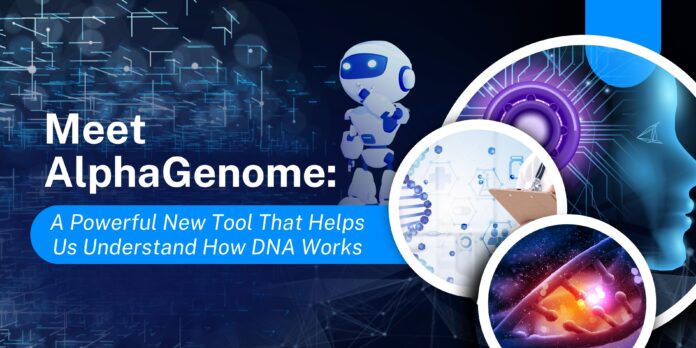AlphaGenome DNA Prediction Tool: Meet a Powerful New Tool That Helps Us Understand How DNA Works
AlphaGenome DNA prediction tool is transforming the way we understand our genetic makeup. AlphaGenome is the new AI model that is reshaping the way we look at ourselves. This powerful tool is designed to help us further understand DNA in detail and pave the way for scientists and researchers to gain a thorough understanding of DNA and its mutations. The tool is primarily designed to predict the consequences of a slight change in the DNA structure with high accuracy and detail.
One of the greatest news is that this model is freely available for scientists and researchers and can be used for any non-commercial purposes. This can be easily accessed through an API portal.
Understanding the importance of AlphaGenome:
As we all know, DNA is the building block of life, containing the instructions necessary for the overall functioning of living organisms. Any slight change in the structure can lead to drastic changes in the gene function, which can further lead to diseases, disorders, or even be fatal. However, understanding exactly how these changes affect the body at the molecular level remained a significant mystery in science. Now, alphagenome is helping in solving this scientific mystery.
What AlphaGenome Does
AlphaGenome is an AI model that examines long sequences of DNA—up to 1 million letters long—and predicts how these sequences control various biological processes.
It can also inform scientists about how a mutation might alter these processes by comparing the original DNA with the mutated version. The model predicts thousands of things like:
- Where genes start and end
- How genes are spliced (cut and rearranged)
- How much RNA is made
- Which proteins might bind to the DNA
To train the model, the developers utilized large datasets from public projects such as ENCODE, GTEx, 4D Nucleome, and FANTOM5. These datasets include information from hundreds of human and mouse tissues and cell types.
How It Works
The model begins by identifying small patterns in the DNA using a method known as convolutional layers. Then it utilizes transformers, which are a type of AI technology. This will help in examining how the entire sequence functions as a whole. Finally, it turns all of this into predictions about what’s happening in the DNA.
All of this was accomplished using advanced computer systems known as TPUs. and the training of one AlphaGenome model took only 4 hours, using half the computing power of its earlier version, Enformer.
How Is It Different from Older Models?
AlphaGenome improves on earlier models in many ways:
- Looks at Longer DNA with More Detail
It can examine a full million DNA letters and still provide detailed predictions down to each base (the building blocks of DNA). Older models had to choose between long sequences or high detail, but AlphaGenome does both.
- Predicts More Things at Once
It provides predictions for a wide range of gene regulation activities simultaneously. This makes it easier for scientists to obtain a comprehensive understanding of how a mutation may impact the genome.
- Fast Variant Scoring
AlphaGenome can quickly measure the effect of a mutation by comparing the original and changed sequences in just one second.
- Models RNA Splicing
For the first time, a model can directly predict RNA splice junctions, the places where RNA is cut and joined. Mistakes in this process cause many rare diseases like spinal muscular atrophy and some forms of cystic fibrosis.
- Best-in-Class Accuracy
AlphaGenome performed better than top models in 22 out of 24 tests for DNA sequences and 24 out of 26 for mutations. It was the only model that could do all of these tasks together.
“It’s a milestone for the field. For the first time, we have a single model that unifies long-range context, base-level precision and state-of-the-art performance across a whole spectrum of genomic tasks.”
— Dr. Caleb Lareau, Memorial Sloan Kettering Cancer Center
Why This Matters to Scientists
With the AlphaGenome DNA prediction tool, researchers can test multiple hypotheses with just one API call. This speeds up research and removes the need to use several separate models for each task. The model can also be used for fine-tuning the new datasets. This enables many scientists to find answers to most unanswered questions.
In the future, AlphaGenome’s capabilities can be expanded by incorporating additional training data, including data from other species, or by introducing new biological features.
Real-Life Example
In one of the tudy on T-cell acute lymphoblastic leukemia (T-ALL), scientists utilized AlphaGenome to investigate mutations present in patients. The model predicted that the mutation would activate a nearby gene called TAL1, which matches what scientists already knew about the disease. This shows how AlphaGenome can help connect non-coding mutations to the genes they affect.
Professor Marc Mansour from the University College London stated that, “AlphaGenome will be a powerful tool for the field. Determining the relevance of different non-coding variants can be extremely challenging, particularly to do at scale.”
Where AlphaGenome Can Help
Here’s where this new tool can make a significant impact:
- Understanding Diseases: Especially useful for studying rare or hard-to-spot mutations, which may be linked to diseases.
- Synthetic Biology: Scientists can design new DNA with specific functions, like turning on a gene in nerve cells but not in muscle cells.
- Basic Genomic Research: Helps map and define essential parts of the genome and understand how they work.
Current Limitations
Eventhough the AlphaGenome is a big step forward, it is still not perfect. It has a few limitations in predicting the exact DNA regions that are 100,000 base pairs away. Additionally, it also requires further improvement to capture cell- and tissue-specific patterns.
Importantly, the model is not made for personal genome analysis or clinical use. It only predicts molecular outcomes, not comprehensive health traits, which also depend on factors such as environment and development.
Available Now for Research Use
AlphaGenome is available now for non-commercial research through the AlphaGenome API. The predictions are for research purposes only and should not be used in any clinical or medical decisions.
Scientists worldwide are encouraged to try the model, share their ideas, and ask questions on the community forum. The main aim is to understand and enhance the model and make it user friendly as well as more and more accurate. It is available freely to enable more people to benefit from its capabilities.
As the usage of this powerful tool increases, researchers can unveil the secrets of our genome, which can further lead to various discoveries in biology. It can help develop treatments for multiple diseases. It can finally answer questions such as how exactly our DNA functions!
























I’m the B. Tech Biotech. graduate wants to associate and drive myself with an organization where there is an opportunity to contribute and update my knowledge in the field of Life science and strive hard for organizational and
personal growth.